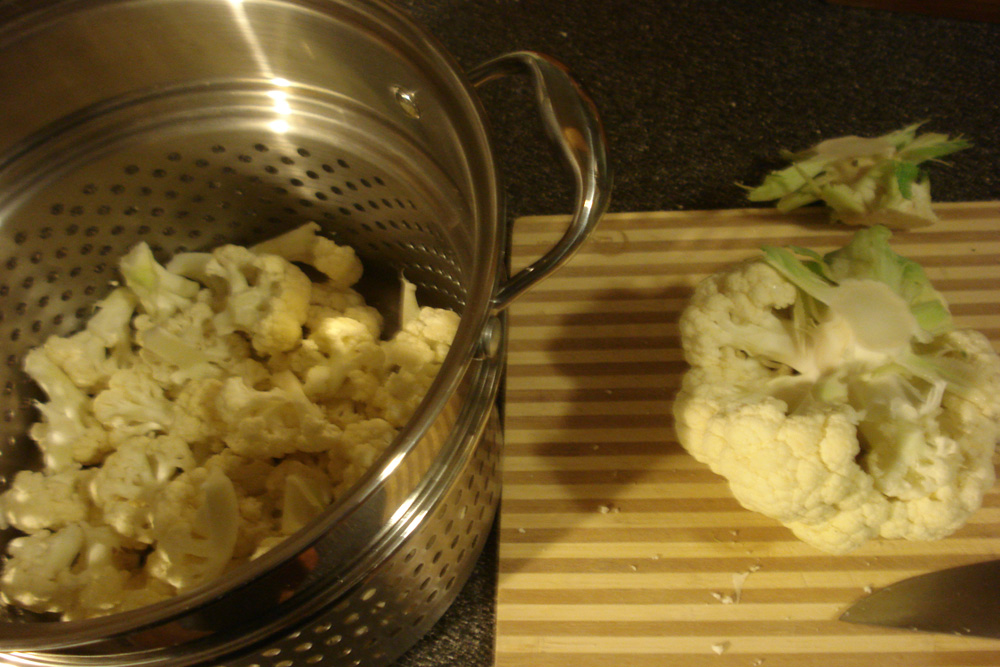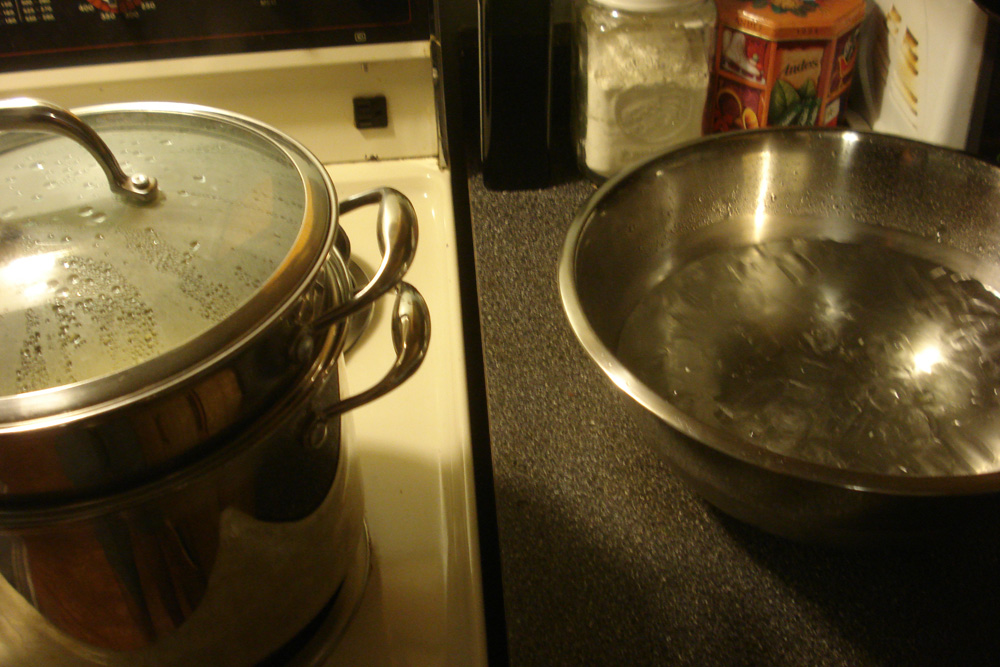 I love eating local veggies well into the winter. I feel like I'm cheating our short season here in Newfoundland by enjoying 100% local stir-frys and fruit-smoothies in February. If you do have the freezer space it's usually cheaper, too, to buy a bunch of local broccoli or zucchini when they're plentiful rather than buying expensive, wilting vegetables at the grocery store in the middle of winter.
I love eating local veggies well into the winter. I feel like I'm cheating our short season here in Newfoundland by enjoying 100% local stir-frys and fruit-smoothies in February. If you do have the freezer space it's usually cheaper, too, to buy a bunch of local broccoli or zucchini when they're plentiful rather than buying expensive, wilting vegetables at the grocery store in the middle of winter.
I tried to keep this short but it's probably way too long. What follows is a list of some of the things you can freeze and keep, and some tips I've learned that make it work well.
Most vegetables can be kept by canning, pickling, etc., and a lot of root veggies keep for months in cold storage, but for many fruits and veggies freezing is the best way to enjoy them like fresh, without a big change in taste or nutrition. Luckily freezing is really easy with a few handy tips.
Berries/fruit
Most fruit can be frozen raw and will keep for a year or more. Since I only preserve local food I mostly have experience with freezing berries. Freezing blueberries is pretty standard fare here in Newfoundland, but I can offer one tip that comes in handy for freezing virtually everything: Lay out the dry fruit or veggies on a baking sheet to freeze.
I store everything in ziplock (or equivalent brand) freezer bags that seal airtight. But you can't just throw your fruits and veggies right into the ziplock and then into the freezer. When you go to grab a handful of berries for a smoothie or what-have-you, you might find that they're all stuck together! I would guess that this is rarely a big problem for something like blueberries, but it's really important for anything wet, gooey, or sticky.
For example, when I freeze strawberries I wash them and cut/pull off the tops. I might also cut them in half or quarters if they are large, so that I can use them right out of the bag at the size I want. That leaves a bit of strawberry juice running over all the berries. If you freeze them all together in a bag, the liquid makes them stick together, and to the bag. Instead, freeze them on a pan for a few hours, then remove them from the pan with a spoon or spatula, and scoop into a bag. At most you'll have a few little clumps of berries, rather than one big solid berry mass.
As I do with Strawberries, you generally want to cut to desired size before freezing.There's nothing fun about waiting for something to thaw just so you can cut it in to smaller bits. Cut it to
the size you will want it to be when you throw it into your cereal, stir-fry, smoothie, etc. For cooked dishes you can throw it in without thawing. For something like berries in your granola, they get soggy as they thaw, so you wouldn't want to have to cut that giant strawberry before using it.
Veggies
The majority of vegetables need to be blanched before freezing. If you freeze them raw, they continue to go bad, only slower. If vegetables are cooked to just the right amount and then quickly frozen, they keep for months. Overcooking the vegetables will result in them going bad faster, and probably being mushy and flavourless.
To blanch vegetables you must boil for about 2 - 5 minutes (depending on the vegetable), then submerge in ice water or cold running water for a few minutes to stop the cooking process as quickly as possible.
You can blanch and freeze: broccoli, cauliflower, Brussels sprouts, zucchini, carrots, peas, corn, asparagus, celery, greens, and a lot more!
Here are a couple of guides to blanching times and methods. They're pretty consistent, with a few differences in timing.
A good way to keep your veggies tasty is to steam instead of boil when blanching (works better for some veggies than others - see guides). If you have a good pot with a steaming basket that fits in the pot, you can quickly take all the vegetables out and submerge them in ice water. This is true if you're boiling too.
Once you've blanched and cooled the vegetables, you want to get them as dry as possible and then in the freezer as quickly as you can. To dry the vegetables you can just drain the veggies for a few minutes, or dry them with a clean cloth or towel. Put them on a tray and in the freezer for a few hours, scooping them in to a bag later on, once they've become fairly frozen.
One big problem I always run into when freezing veggies is doing too much at once! A freezer can only freeze so much food in a given amount of time. If you put pounds and pounds of room temperature food in a freezer, you'll notice after a few hours that your food isn't frozen yet and, in fact, your other food has started to thaw slightly. Be careful not to overload your freezer. I like to do one type of veggie per weekend throughout the fall.
If you're doing lots of veggies and cooling them in ice water you'll also start to run out of ice pretty quickly. It's another reason to do small batches, but you can also help yourself out by buying a bag of ice at a convenience store, or by making the same thing yourself over a couple of days using your own ice-cube trays.
When you do use your frozen veggies, there will undoubtebly be some extra water in the mix, so try to compensate in a recipe by reducing water, or just be careful when cooking. Thawing the veggies in advance might help with this.
Peppers
Although many vegetables need to be blanched before freezing, peppers are a convenient exception. They can be frozen blanched or raw. I have hot peppers (cayenne, Habanero, etc.) that I froze raw in my freezer now which are a year old and still good. Hot peppers and bell peppers should be seeded and cut to size before freezing in a ziplock bag or other airtight container. Use gloves anytime you're working with hot peppers to avoid getting the oil that makes them hot on your skin, in your eyes, etc. You can find plenty of remedies for the ensuing burning on the internet, but I've found that they don't really work :)
For some reason I don't follow my own advice when doing hot peppers, leaving them whole rather than diced. I think the reasoning here is that they'll keep better whole (less surface area), and I only use one pepper (or less) per meal, so I don't have to chop up too much frozen pepper. I do dice bell peppers for freezing.
Pesto
I don't really have a great pesto recipe to share, as I've only made it a couple of times, but it is something you can easily freeze as a way to save your herbs for later. Pesto can be made with a variety of different herbs. The basic basil pesto recipe is:
- chopped basil leaves
- chopped pine nuts
- grated parmesan cheese
- olive oil
- minced garlic
- salt & pepper
I've also made an oregano pesto. You can find some pesto recipes in the Dips, Spreads, Sauces, Dressings & Condiments section of this website. Pesto uses a lot of herbs. Once you've chopped herbs into tiny bits (I use a food processor... you might be able to get away with a blender), they really shrink in volume. It's a great way to use a huge herb harvest all at once.
Anyway, one of the great things about pesto is how easy it is to store in the freezer! Once your pesto is made, just spoon the pesto into an ice-cube tray to freeze. After a few hours you can break out your pesto cubes into a freezer bag for long-time storage. To use your frozen pesto cubes just take out a couple to thaw, or drop them right in with some sautéing vegetables, or mix with cooked pasta.
Those are just a few of the ways to freeze food that I've tried. I know people make freezer jams, too, and of course meat can be frozen easily. Does anyone have any favourite freezer preserve recipes or techniques to share?










